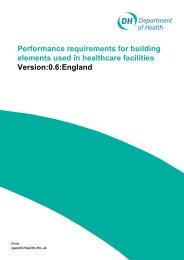Early Life Nutrition and Lifelong Health - Derbyshire Local Medical ...
Early Life Nutrition and Lifelong Health - Derbyshire Local Medical ...
Early Life Nutrition and Lifelong Health - Derbyshire Local Medical ...
Create successful ePaper yourself
Turn your PDF publications into a flip-book with our unique Google optimized e-Paper software.
BMA Board of Sciencewith less ‘obesogenic’ family characteristics. 191, 192 A recent study showed however, that fat massassessed using DXA at age nine to 10 years was inversely related to the duration of breastfeeding<strong>and</strong> this association, although attenuated, was robust to adjustment for a range of confoundingfactors. 192 On the other h<strong>and</strong>, there were no differences in skinfold thickness at six years of agebetween children in the two arms of the Belarus trial. 180Mechanisms that could protect breastfed babies from later obesity include aspects of the feedingprocess or particular constituents of breast milk. As already mentioned, breastfed infants may learnto regulate their energy intake more effectively. Breastfed babies grow more slowly in infancy thanformula-fed babies, which may be protective. Constituents of milk, such as protein, may influence127, 193body composition through effects on hormones such as insulin <strong>and</strong> IGF-1.Key messageBreastfeeding is associated with a lower mean BMI in later life, <strong>and</strong> a longer duration ofbreastfeeding is associated with lower rates of obesity. Breastfed babies grow more slowly ininfancy than formula-fed babies, which may be protective against the later development ofobesity. There is also evidence that breastfeeding is associated with a lower risk of both type 1<strong>and</strong> type 2 diabetes <strong>and</strong> some forms of cancer, <strong>and</strong> lower LDL-cholesterol concentrations inchildhood <strong>and</strong> adulthood.DiabetesType 1 diabetes is an auto-immune disease in which antibodies are formed against components ofthe pancreatic beta cells, leading to insulin secretory failure. It usually presents in childhood oradolescence. Case-control studies have shown a 30 to 50 per cent reduced risk of type 1 diabetesin children who were breastfed, but more evidence is required in this area. It has been suggestedthat the avoidance of cow’s milk formula is important rather than breastfeeding per se, becausethere is structural similarity between bovine albumin <strong>and</strong> beta cell surface proteins, <strong>and</strong> childrenpresenting with type 1 diabetes have elevated antibodies to bovine albumin. 194Type 2 diabetes is a common disease <strong>and</strong>, until recently, usually presents in middle-to-old age. It isstrongly associated with obesity, <strong>and</strong> the underlying cause is insulin resistance, which imposes anincreased dem<strong>and</strong> for insulin that eventually ‘exhausts’ the pancreatic beta cells. The obesityepidemic in Western countries has led to increasing numbers of children presenting with type 2diabetes. It has been estimated that there could be 1,400 children with type 2 diabetes <strong>and</strong>20,000 with pre-diabetes (impaired glucose tolerance (IGT)) undetected in the UK. 195 There is someevidence that breastfeeding protects against the risk of developing type 2 diabetes in later life,possibly through effects on adiposity. A meta-analysis of seven studies showed a reduced risk in six(overall OR 0.61; 95% CI 0.44 to 0.85; p=0.003). 196 This was little changed after adjusting forconfounding factors (maternal size, birth weight, parental diabetes, socio-economic status <strong>and</strong>adult body size).42<strong>Early</strong> life nutrition <strong>and</strong> lifelong health



